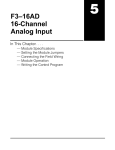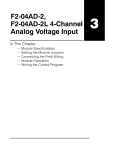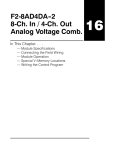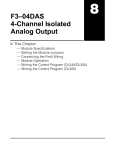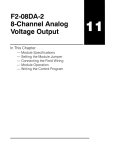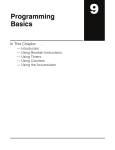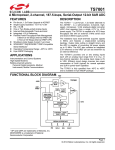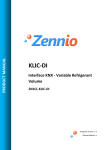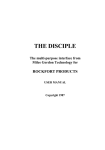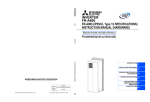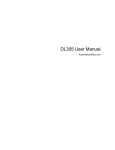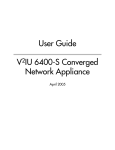Download F3–08THM–n 8-Channel Thermocouple Input
Transcript
F3–08THM–n 8-Channel Thermocouple Input In This Chapter. . . . Ċ Introduction Ċ Module Specifications Ċ Setting the Module Switches Ċ Connecting the Field Wiring Ċ Module Operation Ċ Writing the Control Program 19 9–2 F3–08THM–n 8-Channel Thermocouple Input Introduction Automatic Conversion The F3–08THM–n Thermocouple Input Module provides eight, differential thermocouple input channels (12-bit resolution). The module automatically converts type E, J, K, R, S or T thermocouple signals into direct temperature readings. No extra scaling or complex conversion is required. You can select between _F or _C operation. This module is also available in versions specially designed to convert millivolt signal levels into direct digital values (0–4095). Two versions are available, one for 0–50mV and one for 0–100mV. Hardware Features The F3–08THM–n also features automatic cold junction compensation, thermocouple linearization, plus analog and digital filtering. The temperature calculation and linerazation are based on data provided by the National Bureau of Standards. F3–08THM–n 8Ch. Thermocouple In. Diagnostic Features Thermocouple burnout and other errors are automatically reported to the CPU. For example, if the thermocouple becomes disconnected, then a value of 4095 is assigned to that channel. 9–3 F3–08THM–n 8-Channel Thermocouple Input Module Specifications The following table provides the specifications for the F3–08THM–n Thermocouple Input Module from FACTS Engineering. Review these specifications to make sure the module meets your application requirements. 8, differential inputs Input Ranges Type E: –270/1000 _C, –450/1832 _F Type J: –210/760 _C, –350/1390 _F Type K: –270/1370 _C, –450/2500 _F Type R: 0/1768 _C, –32/3214 _F Type S: 0/1768 _C, –32/3214 _F Type T: –270/400 _C, –450/752 _F –1: 0 – 50 mV –2: 0–100 mV Resolution 12 bit (1 in 4096) Input Impedance 27KW DC Absolute Maximum Ratings Fault protected input, 130 Vrms or 100 VDC Cold Junction Compensation Automatic Conversion Time 15ms per channel, minimum 1 channel per CPU scan Converter Type Successive Approximation, 574 Linearity Error "1 count (0.03% of full scale) maximum Maximum Inaccuracy at 77 °F (25 °C) 0.35% of full scale Accuracy vs. Temperature 57 ppm / _C maximum full scale Power Budget Requirement 50 mA @ 9 VDC, 34 mA @ 24 VDC External Power Supply None required Operating Temperature 32° to 140° F (0° to 60° C) Storage Temperature –4° to 158° F (–20° to 70° C) Relative Humidity 5 to 95% (non-condensing) Environmental air No corrosive gases permitted Vibration MIL STD 810C 514.2 Shock MIL STD 810C 516.2 Noise Immunity NEMA ICS3–304 The F3–08THM–n Thermocouple Input appears as a 16-point module. The module can be installed in any slot configured for 16 points. See the DL305 User Manual for details on using 16 point modules in DL305 systems. The limitation on the number of analog modules are: S For local and expansion systems, the available power budget and 16-point module usage are the limiting factors. F3–08THM–n 8Ch. Thermocouple In. Analog Input Configuration Requirements Number of Channels 9–4 F3–08THM–n 8-Channel Thermocouple Input Setting the Module Jumpers Jumper Locations The module is set at the factory for _C thermocouple readings. If this is acceptable you do not have to change any of the jumpers. The following diagram shows how the jumpers are set. WARNING: DO NOT change the calibration jumper settings. If you think this jumper has been changed, make sure it is NOT in the CAL position. All calibration is performed at the factory. Any changes to this may affect the module accuracy which could result in the risk of personal injury and/or equipment damage. Selecting _F or _C Operation There is a jumper located on the bottom of the board that selects between _C and _F temperature measurements. This jumper (labeled _F) should be removed if you require _C measurements. Measurement Selection _F CNTS Remove this jumper for _C operation. F3–08THM–n 8Ch. Thermocouple In. Selecting 0–4095 Operation There is a jumper located on the bottom of the board that allows you to disable the direct temperature conversion feature. If you install a jumper on the CNTS pin, the temperature will be represented by a digital value between 0 and 4095. For example, an E type thermocouple would have a value of 0 for –450 _F and a value of 4095 for 1832 _F. NOTE: If you are using the –1 (50mV) or the –2 (100mV) millivolt input versions, you should make sure this jumper is installed. Measurement Selection _F CNTS Install this jumper to obtain digital values (0 – 4095). 9–5 F3–08THM–n 8-Channel Thermocouple Input Connecting the Field Wiring Wiring Guidelines Your company may have guidelines for wiring and cable installation. If so, you should check those before you begin the installation. Here are some general things to consider. S Use the shortest wiring route whenever possible. S Use shielded wiring and ground the shield at the signal source. Do not ground the shield at both the module and the source. S Don’t run the signal wiring next to large motors, high current switches, or transformers. This may cause noise problems. S Route the wiring through an approved cable housing to minimize the risk of accidental damage. Check local and national codes to choose the correct method for your application. User Power Supply The F3–08THM–n receives all power from the base. A separate power supply is not required. Requirements Wiring Diagram Note 1: Terminate shields at the respective signal source Note 2: Leave unused channels open (no connection) Internal Module Wiring THERMOCOUPLE F3–08THM A/D See note C C –1 –1 CH1 +1 +1 –2 –2 Examples of differential Thermocouple wiring +2 +2 CH3 +3 +3 C C –4 –4 +4 +4 –5 +5 C –6 CH6 +6 –7 Examples of grounded Thermocouple wiring +7 –8 CH8 +8 C Analog Switch –5 +5 C –6 +6 –7 +7 –8 +8 C F3–08THM–n 8Ch. Thermocouple In. –3 –3 9–6 F3–08THM–n 8-Channel Thermocouple Input Module Operation Channel Scanning Sequence Before you begin writing the control program, it is important to take a few minutes to understand how the module processes and represents the analog signals. The F3–08THM–n module supplies1 channel of data per each CPU scan. Since there are eight channels, it can take up to eight scans to get data for all channels. Once all channels have been scanned the process starts over with channel 1. Scan I/O Update Channel 1 Scan N Execute Application Program Channel 2 Scan N+1 Channel 8 Scan N+7 Channel 1 Scan N+8 F3–08THM–n 8Ch. Thermocouple In. . . . Read the data . . . Store data Even though the channel updates to the CPU are synchronous with the CPU scan, the module asynchronously monitors the thermocouple signal and converts the signal to a temperature (or 12-bit binary) representation. This enables the module to continuously provide accurate measurements without slowing down the discrete control logic in the RLL program. 9–7 F3–08THM–n 8-Channel Thermocouple Input Understanding the You may recall the F3–08THM–n module appears to the CPU as a 16-point module. These 16 points provide: I/O Assignments S an indication of which channel is active. S the digital representation of the temperature. Since all I/O points are automatically mapped into Register (R) memory, it is very easy to determine the location of the data word that will be assigned to the module. F3–08THM 8pt Relay 8pt Output 8pt Output 050 – 057 040 – 047 030 – 037 16pt Input 8ch (Analog) 020 027 – 120 127 R 002, R012 010 017 – 110 117 16pt Input 000 007 – 100 107 R 000, R010 R 011 MSB 1 1 7 R 001 LSB MSB 1 1 0 LSB 0 1 0 0 1 7 Within these two register locations, the individual bits represent specific information about the analog signal. The next to last three bits of the upper Register indicate the active channel. The indicators automatically increment with each CPU scan. Active Channel Scan Inputs Channel N 000 1 N+1 001 2 N+2 010 3 N+3 011 4 N+4 100 5 N+5 101 6 N+6 110 7 N+7 111 8 N+8 000 1 R011 MSB LSB 1 1 1 1 1 1 1 1 1 1 1 1 1 1 1 1 7 6 5 4 3 2 1 0 - active channel indicator inputs F3–08THM–n 8Ch. Thermocouple In. Active Channel Indicator Inputs 9–8 F3–08THM–n 8-Channel Thermocouple Input Temperature Sign Bit The most significant bit is used to note the sign of the temperature. If this bit is on, then the temperature is negative. If the bit is off, then the temperature is positive. R011 MSB LSB 1 1 1 1 1 1 1 1 1 1 1 1 1 1 1 1 7 6 5 4 3 2 1 0 - temperature sign Analog Data Bits Temperature Input Resolution F3–08THM–n 8Ch. Thermocouple In. Millivolt Input Resolution The first twelve bits represent the temperature. If you have selected the 0–4095 scale, the following format is used. Bit Value Bit Value 0 (LSB) 1 6 64 1 2 7 128 2 4 8 256 3 8 9 512 4 16 10 1024 5 32 11 2048 R011 R001 MSB LSB 1 1 1 1 11 1 1 1 1 1 1 11 1 1 7 6 5 4 32 1 0 0 0 0 0 0 0 0 0 1 1 1 1 1 1 1 1 7 6 5 4 3 2 1 0 - data bits Typically, the F3–08THM–n resolution enables you to detect a 1 _C change in temperature. The National Bureau of Standards publishes conversion tables that show how each temperature corresponds to an equivalent signal level. Since the module has 12-bit resolution, the analog signal is converted into 4096 “pieces” ranging from 0 – 4095 (212). For example, with a –2 (100mV) module a signal of 0 mV would be 0, and a signal of 100 mV would be 4095. This is equivalent to a a binary value of 0000 0000 0000 to 1111 1111 1111, or 000 to FFF hexadecimal. The diagram shows how this relates to the example signal range. Each “piece” can also be expressed in terms of the signal level by using the equation shown. The following table shows the smallest signal levels that will result in a change in the data value for each signal range. Range 0–100 mV Scale 100mV 0 mV 0 4095 Resolution + H * L 4095 H = high limit of the signal range L = low limit of the signal range Highest Signal Lowest Signal Smallest Change 0 – 50 mV 50 mV 0 mV 12.2 mV 0 – 100 mV 100mA 0mA 24.2 mV Now that you understand how the module and CPU work together to gather and store the information, you’re ready to write the control program. 9–9 F3–08THM–n 8-Channel Thermocouple Input Writing the Control Program (DL330 / DL340) Identifying the Data Locations Since all channels are multiplexed into a single data word, the control program must be setup to determine which channel is being read. Since the module provides input points to the CPU, it is very easy to use the channel status bits to determine which channel is being monitored. F3–08THM 8pt Relay 8pt Output 8pt Output 050 – 057 040 – 047 030 – 037 16pt Input 020 027 – 120 127 R 002, R012 8ch (Analog) 010 017 – 110 117 16pt Input 000 007 – 100 107 R 000, R010 R 011 MSB R 001 LSB 1 1 1 1 1 1 1 1 7 6 5 4 1 1 0 MSB 0 1 7 LSB 0 1 0 - temperature sign Automatic Temperature Conversion If you are using the temperature scale (°F or° C) then you do not have to perform any scaling. Once you convert the binary temperature reading to a four-digit BCD number, you have the temperature. F3–08THM–n 8Ch. Thermocouple In. - active channel indicator inputs - data bits 9–10 F3–08THM–n 8-Channel Thermocouple Input The following example shows a program designed to read any of the available channels of data into Register locations. Once the data is in a Register, you can perform math on the data, compare the data against preset values, etc. Since the DL305 CPUs use 8-bit word instructions, you have to move the data in pieces. It’s simple if you follow the example. Read the data 374 Store channel 1 114 115 116 F3–08THM–n 8Ch. Thermocouple In. Store channel 2 114 115 116 Store channel 3 114 115 116 Store channel 4 114 115 116 Store channel 5 114 115 116 Store channel 6 114 115 116 Store channel 7 114 115 116 Store channel 8 114 115 116 DSTR3 R011 F53 This rung loads the four data bits into the accumulator from Register 011 on every scan. DOUT1 R501 F61 Temporarily store the bits to Register 501. DSTR1 R001 F51 This rung loads the eight data bits into the accumulator from Register 001. DOUT1 R500 F61 Temporarily store the bits to Register 500. Since the most significant bits were loaded into 501, now R500 and R501 contain all twelve bits in order. DSTR R500 F50 Now that all the bits are stored, load all twelve bits into the accumulator. BCD F86 DOUT R400 F60 DOUT R402 F60 DOUT R404 F60 DOUT R406 F60 DOUT R410 F60 DOUT R412 F60 DOUT R414 F60 DOUT R416 F60 Math operations are performed in BCD. This instruction converts the binary data to BCD. (You can omit this step if your application does not require the conversion.) The channel selection inputs are used to let the CPU know which channel has been loaded into the accumulator. By using these inputs to control a DOUT instruction, you can easily move the data to a storage register. Notice the DOUT instruction stores the data in two bytes. (Two bytes are required for four digit BCD numbers.) 9–11 F3–08THM–n 8-Channel Thermocouple Input Using the Sign Bit By adding a couple of simple rungs you can easily monitor the temperature for positive vs. negative readings. (For example, you have to know whether the temperature is +100 _F or –100 _F.) Notice how we’ve changed Channel 2 to control an output that denotes the sign of the temperature. Read the data 374 Store channel 1 114 115 116 Store channel 2 114 115 116 114 115 116 DSTR3 R011 F53 This rung loads the four data bits into the accumulator from Register 011 on every scan. DOUT1 R501 F61 Temporarily store the bits to Register 501. DSTR1 R001 F51 This rung loads the eight data bits into the accumulator from Register 001. DOUT1 R500 F61 Temporarily store the bits to Register 500. Since the most significant bits were loaded into 501, now R500 and R501 contain all twelve bits in order. DSTR R500 F50 Now that all the bits are stored, load all twelve bits into the accumulator. BCD F86 DOUT R400 F60 DOUT R402 F60 117 200 114 115 116 117 200 RST Store channel 3 114 115 116 Store channel 4 114 115 116 DOUT R404 F60 DOUT R406 F60 The channel selection inputs are used to let the CPU know which channel has been loaded into the accumulator. By using these inputs to control a DOUT instruction, you can easily move the data to a storage register. Notice the DOUT instruction stores the data in two bytes. (Two bytes are required for four digit BCD numbers.) If 117 is on, then the temperature on channel 2 is negative. If 117 is off, then the temperature on channel 2 is positive. F3–08THM–n 8Ch. Thermocouple In. SET Math operations are performed in BCD. This instruction converts the binary data to BCD. (You can omit this step if your application does not require the conversion.) 9–12 F3–08THM–n 8-Channel Thermocouple Input Scaling the Input Data If you are using the –1 (50mV) or the –2 (100mV) versions, you may want to scale the data to represent the measurements in engineering units, which provide more meaningful data. This is accomplished by using the conversion formula shown. Units + A S 4096 Units = value in Engineering Units A = Analog value (0 – 4095) S = high limit of the Engineering unit range NOTE: The thermocouple versions automatically provide the correct temperature readings. Scaling is not required. The following example shows how you would use the analog data to represent pressure (PSI) from 0 to 100. This example assumes the analog value is 1760. This should yield approximately 42.9 PSI. Units + A S 4096 Units + 1760 100 4096 F3–08THM–n 8Ch. Thermocouple In. Units + 42.9 9–13 F3–08THM–n 8-Channel Thermocouple Input The following instructions are required to scale the data. (We’ll continue to use the 42.9 PSI example.) Once we’ve explained how these instructions operate, we’ll show an example program. This example assumes you have already read the analog data and stored the BCD equivalent in R400 and R401 Scale the data 114 115 116 DSTR R400 F50 This instruction brings the analog value (in BCD) into the accumulator. Accumulator Aux. Accumulator 1 7 6 0 0 0 0 0 R577 DIV K4096 F74 The analog value is divided by the resolution of the module, which is 4096. (1760 / 4096 = 0.4296) Accumulator Aux. Accumulator 0 0 0 0 4 2 9 6 R577 DSTR R576 F50 F73 F50 R576 The accumulator is then multiplied by the scaling factor, which is 100. (100 x 4296 = 429600). Notice the most significant digits are now stored in the auxilliary accumulator. (This is different from the way the Divide instruction operates.) 9 DSTR R576 R576 This instruction moves the two-byte decimal portion into the accumulator for further operations. Accumulator Aux. Accumulator 4 2 9 6 4 2 9 6 R577 MUL K100 R576 Accumulator 6 0 0 Aux. Accumulator 0 0 4 2 R577 R576 DOUT R450 F60 R577 R576 This instruction stores the accumulator to R450 and R451. R450 and R451 now contain the PSI, which is 42 PSI. Accumulator Store in R451 & R450 0 0 4 2 0 0 4 2 R451 R450 F3–08THM–n 8Ch. Thermocouple In. This instruction moves the two-byte auxilliary accumulator for further operations. Accumulator Aux. Accumulator 0 0 4 2 0 0 4 2 9–14 F3–08THM–n 8-Channel Thermocouple Input You probably noticed the previous example yielded 42 PSI when the real value should have been 42.9 PSI. By changing the scaling value slightly, we can “imply” an extra decimal of precision. Notice in the following example we’ve added another digit to the scale. Instead of a scale of 100, we’re using 1000, which implies 100.0 for the PSI range. This example assumes you have already read the analog data and stored the BCD equivalent in R400 and R401 Scale the data 114 115 116 DSTR R400 F50 This instruction brings the analog value (in BCD) into the accumulator. Accumulator Aux. Accumulator 1 7 6 0 0 0 0 0 R577 DIV K4096 F74 The analog value is divided by the resolution of the module, which is 4096. (1760 / 4096 = 0.4296) Accumulator Aux. Accumulator 0 0 0 0 4 2 9 6 R577 DSTR R576 F50 F73 F3–08THM–n 8Ch. Thermocouple In. F50 R576 The accumulator is multiplied by the scaling factor, which is now 1000. (1000 x 4296 = 4296000). The most significant digits are now stored in the auxilliary accumulator. (This is different from the way the Divide instruction operates.) 6 DSTR R576 R576 This instruction moves the two-byte decimal portion into the accumulator for further operations. Accumulator Aux. Accumulator 4 2 9 6 4 2 9 6 R577 MUL K1000 R576 Accumulator 0 0 0 Aux. Accumulator 0 4 2 9 R577 R576 This instruction moves the two-byte auxilliary accumulator for further operations. Accumulator Aux. Accumulator 0 4 2 9 0 4 2 9 DOUT R450 F60 R577 R576 This instruction stores the accumulator to R450 and R451. R450 and R451 now contains the PSI, which implies 42.9. Accumulator Store in R451 & R450 0 4 2 9 0 4 2 9 R451 R450 9–15 F3–08THM–n 8-Channel Thermocouple Input This example program shows how you can use the instructions to load these equation constants into data registers. The example is written for channel 1, but you can easily use a similar approach to use different scales for all channels if required. You may just use the appropriate constants in the instructions dedicated for each channel, but this method allows easier modifications. For example, you could easily use an operator interface or a programming device to change the constants if they are stored in Registers. Load the constants 374 Read the data 374 F50 DOUT R430 F60 DSTR K1000 F50 DOUT R432 F60 DSTR3 R011 F53 This rung loads the four most significant data bits into the accumulator from Register 011 on every scan. DOUT1 R501 F61 Temporarily store the bits to Register 501. DIV R430 F74 The analog value is divided by the resolution of the module, which is stored in R430 and R431. DSTR R576 F50 This instruction moves the decimal portion from the auxilliary accumulator into the regular accumulator for further operations. MUL R432 F73 The accumulator is multiplied by the scaling factor, which is stored in R432 and R433. DSTR R576 F50 This instruction moves most significant digits (now stored in the auxilliary accumulator) into the regular accumulator for further operations. DOUT R400 F60 The scaled value is stored in R400 and R401 for further use. These two instructions load the high limit of the Engineering unit scale (constant of 1000) into R432 and R433. Note, if you have different scales for each channel, you’ll also have to enter the Engineering unit high limit for those as well. F3–08THM–n 8Ch. Thermocouple In. Store channel 1 114 115 116 On the first scan, these first two instructions load the analog resolution (constant of 4096) into R430 and R431. DSTR K4096 9–16 F3–08THM–n 8-Channel Thermocouple Input Writing the Control Program (DL350) Reading Values: Pointer Method and Multiplexing There are two methods of reading values for the DL350: S The pointer method (all system bases must be D3–xx–1 bases to support the pointer method) S Multiplexing You must use the multiplexing method with remote I/O modules (the pointer method will not work). You can use either method when using DL350, but for ease of programming it is strongly recommended that you use the pointer method. Pointer Method The DL350 has special V-memory locations assigned to each base slot that greatly simplifies the programming requirements. These V-memory locations allow you to: S specify the data format S specify the number of channels to scan S specify the storage locations The example program shows how to setup these locations. Place this rung anywhere in the ladder program or in the Initial Stage if you are using RLL PLUS instructions. This is all that is required to read the data into V-memory locations. Once the data is in V-memory, you can perform math on the data, compare the data against preset values, and so forth. V2000 is used in the example, but you can use any user V-memory location. In this example the module is installed in slot 2. You should use the V-memory locations for your module placement. SP0 F3–08THM–n 8Ch. Thermocouple In. LD K 08 00 - or - LD K 88 00 Loads a constant that specifies the number of channels to scan and the data format. The upper byte, most significant nibble (MSN) selects the data format (i.e. 0=BCD, 8=Binary), the LSN selects the number of channels (i.e. 1, 2, 3, 4, 5, 6, 7, 8). The binary format is used for displaying data on some operator interfaces. OUT V7662 Special V-memory location assigned to slot 2 that contains the number of channels to scan. LDA O2000 This loads an octal value for the first V-memory location that will be used to store the incoming data. For example, the O2000 entered here would designate the following addresses. Ch1 - V2000, Ch2 - V2001, Ch3 - V2002, Ch4 - V2003, Ch5 – V2004, Ch6 – V2005, Ch7 – V2006, Ch8 – V2007 OUT V7672 The octal address (O2000) is stored here. V7672 is assigned to slot 2 and acts as a pointer, which means the CPU will use the octal value in this location to determine exactly where to store the incoming data. 9–17 F3–08THM–n 8-Channel Thermocouple Input The table shows the special V-memory locations used with the DL350. Slot 0 (zero) is the module next to the CPU, slot 1 is the module two places from the CPU, and so on. Remember, the CPU only examines the pointer values at these locations after a mode transition. The pointer method is supported on expansion bases up to a total of 8 slots away from the DL350 CPU. The pointer method is not supported in slot 8 of a 10 slot base. Analog Input Module Slot-Dependent V-memory Locations Slot 0 1 2 3 4 5 6 7 No. of Channels V7660 V7661 V7662 V7663 V7664 V7665 V7666 V7667 Storage Pointer V7670 V7671 V7672 V7673 V7674 V7675 V7676 V7677 F3–08THM–n 8Ch. Thermocouple In. 9–18 F3–08THM–n 8-Channel Thermocouple Input Multiplexing: DL350 with a D3–XX–1 Base The example below shows how to read multiple channels on an F3–08THM Thermocouple module in the X0 address slot of the D3–xx–1 base. If any expansion bases are used in the system, they must all be D3–xx–1 to be able to use this example. Otherwise, the conventional base addressing must be used. Load the data _On SP1 LDF X0 This loads the analog data from the module. K12 The BCD command converts the data to BCD format. BCD OUT V1400 The scaled value is stored in V1400 with an implied decimal. Channel 1 Select Bit States X14 X15 X16 LD V1400 OUT This writes channel one data to V2000 when bits X14, X15 and X16 are as shown. V2000 Channel 2 Select Bit States X14 X15 X16 LD F3–08THM–n 8Ch. Thermocouple In. V1400 OUT This writes channel two data to V2001 when bits X14, X15 and X16 are as shown. V2001 Channel 3 Select Bit States X14 X15 X16 LD V1400 OUT This writes channel three data to V2002 when bits X14, X15 and X16 are as shown. V2002 Channel 4 Select Bit States X14 X15 X16 LD V1400 OUT V2003 This writes channel four data to V2003 when bits X14, X15 and X16 are as shown. 9–19 F3–08THM–n 8-Channel Thermocouple Input Channel 5 Select Bit States X14 X15 X16 LD V1400 OUT This writes channel five data to V2004 when bits X14, X15 and X16 are as shown. V2004 Channel 6 Select Bit States X14 X15 X16 LD V1400 OUT This writes channel six data to V2005 when bits X14, X15 and X16 are as shown. V2005 Channel 7 Select Bit States X14 X15 X16 LD V1400 OUT This writes channel seven data to V2006 when bits X14, X15 and X16 are as shown. V2006 Channel 8 Select Bit States X14 X15 X16 LD V1400 V2007 Using the Sign Bit X17 is the sign bit when in module address 0. Channel 1 Selected X14 X15 X16 X17 C0 SET X14 X15 X16 X17 C0 RST When the sign bit is on, the sign control relay (C0) is set, causing the temperature on channel one to be negative. When the sign bit is not true, the sign bit control bit is reset, causing the temperature on channel one to be positive. F3–08THM–n 8Ch. Thermocouple In. OUT This writes channel eight data to V2007 when bits X14, X15 and X16 are as shown. 9–20 F3–08THM–n 8-Channel Thermocouple Input Multiplexing: DL350 with a Conventional DL305 Base The example below shows how to read multiple channels on an F3–08THM Thermocouple module in the X20–X27 / 120 –127 address of a DL305 conventional base. The first six channels are shown. Load the data _On SP1 LDF X120 This loads the upper byte of the analog data from the module. K8 SHFL K8 ORF X20 K8 ANDD Kfff BCD This shifts the to the left to make room for the lower byte of data. This brings the lowewr byte of data from the module into the accumulator. This masks off the 12 analog data bits The BCD command converts the data to BCD format. The channel data is stored in V2200. OUT V2200 Channel 1 Select Bit States X124 X125 X126 LD V2200 F3–08THM–n 8Ch. Thermocouple In. OUT Channel 2 Select Bit States X124 X125 X126 This writes channel one data to V3000 when bits X124, X125 and X126 are as shown. V3000 LD V2200 OUT This writes channel two data to V3001 when bits X124, X125 and X126 are as shown. V3001 Channel 3 Select Bit States X124 X125 X126 LD V2200 OUT V3002 This writes channel three data to V3002 when bits X124, X125 and X126 are as shown. 9–21 F3–08THM–n 8-Channel Thermocouple Input Channel 4 Select Bit States X124 X125 X126 LD V2200 OUT This writes channel four data to V3003 when bits X124, X125 and X126 are as shown. V3003 Channel 5 Select Bit States X124 X125 X126 LD V2200 OUT This writes channel five data to V3004 when bits X124, X125 and X126 are as shown. V3004 Channel 6 Select Bit States X124 X125 X126 LD V2200 OUT X16 X17 C0 SET X14 X15 X16 X17 C0 RST When the sign bit is on, the sign control relay (C0) is set, causing the temperature on channel one to be negative. When the sign bit is not true, the sign bit control bit is reset, causing the temperature on channel one to be positive. F3–08THM–n 8Ch. Thermocouple In. X15 V3005 X17 is the sign bit when in module address 0. Channel 1 Negative Temp X14 This writes channel six data to V3005 when bits X14, X15 and X16 are as shown. 9–22 F3–08THM–n 8-Channel Thermocouple Input Scaling the Input Data Most applications usually require measurements in engineering units, which provide more meaningful data. This is accomplished by using the conversion formula shown. You may have to make adjustments to the formula depending on the scale you choose for the engineering units. Units + A H * L 4095 H = high limit of the engineering unit range L = low limit of the engineering unit range A = Analog value (0 – 4095) For example, if you wanted to measure pressure (PSI) from 0.0 to 99.9 then you would have to multiply the analog value by 10 in order to imply a decimal place when you view the value with the programming software or a handheld programmer. Notice how the calculations differ when you use the multiplier. Here is how you would write the program to perform the engineering unit conversion. This example assumes you have BCD data loaded into the appropriate V-memory locations using instructions that apply for the model of CPU you are using. NOTE: This example uses SP1, which is always on. You could also use an X, C, etc. permissive contact. SP1 LD V3000 When SP1 is on, load channel 1 data to the accumulator. MUL K1000 Multiply the accumulator by 1000 (to start the conversion). DIV K4095 Divide the accumulator by 4095. F3–08THM–n 8Ch. Thermocouple In. OUT V3010 Store the result in V3010. 9–23 F3–08THM–n 8-Channel Thermocouple Input Temperature and Digital Value Conversions Since the thermocouple devices are non-linear, it is much easier to rely on published standards for conversion information. The National Bureau of Standards publishes conversion tables that show how each temperature corresponds to an equivalent signal level. Millivolt and Digital Sometimes it is helpful to be able to quickly convert between the signal levels and the Value Conversions digital values. This is especially helpful during machine startup or troubleshooting. The following table provides formulas to make this conversion easier. mV Range If you know the digital value ... If you know the analog signal level ... MV50 0 to 50 mV A + 50D 4095 D + 4095 A 50 MV100 0 to 100 mV A + 100D 4095 D + 4095 A 100 For example, if you are using a –2 (100mV) version and you have measured the signal as 30 mV, you would use the following formula to determine the digital value that should be stored in the register location that contains the data. D + 4095 A 100 D + 4095 (30) 100 D + (40.95) (30) D + 1229 F3–08THM–n 8Ch. Thermocouple In.























